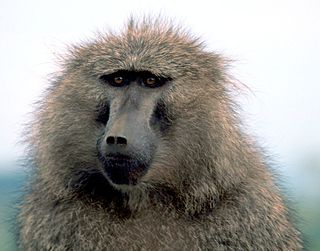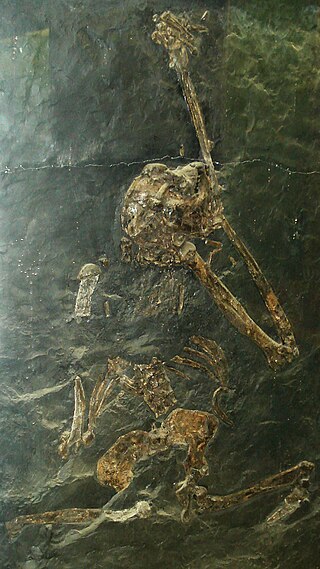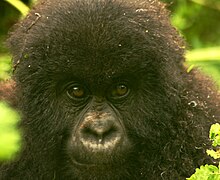
The bonobo, also historically called the pygmy chimpanzee, is an endangered great ape and one of the two species making up the genus Pan. While bonobos are, today, recognized as a distinct species in their own right, they were initially thought to be a subspecies of Pan troglodytes, due to the physical similarities between the two species. Taxonomically, the members of the chimpanzee/bonobo subtribe Panina—composed entirely by the genus Pan—are collectively termed panins.

Primatology is the scientific study of primates. It is a diverse discipline at the boundary between mammalogy and anthropology, and researchers can be found in academic departments of anatomy, anthropology, biology, medicine, psychology, veterinary sciences and zoology, as well as in animal sanctuaries, biomedical research facilities, museums and zoos. Primatologists study both living and extinct primates in their natural habitats and in laboratories by conducting field studies and experiments in order to understand aspects of their evolution and behavior.

The sclera, also known as the white of the eye or, in older literature, as the tunica albuginea oculi, is the opaque, fibrous, protective outer layer of the human eye containing mainly collagen and some crucial elastic fiber.
A facial expression is one or more motions or positions of the muscles beneath the skin of the face. According to one set of controversial theories, these movements convey the emotional state of an individual to observers. Facial expressions are a form of nonverbal communication. They are a primary means of conveying social information between humans, but they also occur in most other mammals and some other animal species.

Oreopithecus is an extinct genus of hominoid primate from the Miocene epoch whose fossils have been found in today's Tuscany and Sardinia in Italy. It existed nine to seven million years ago in the Tusco-Sardinian area when this region was an isolated island in a chain of islands stretching from central Europe to northern Africa in what was becoming the Mediterranean Sea.
The origin of language, its relationship with human evolution, and its consequences have been subjects of study for centuries. Scholars wishing to study the origins of language must draw inferences from evidence such as the fossil record, archaeological evidence, contemporary language diversity, studies of language acquisition, and comparisons between human language and systems of communication existing among animals. Many argue that the origins of language probably relate closely to the origins of modern human behavior, but there is little agreement about the facts and implications of this connection.
Michael Tomasello is an American developmental and comparative psychologist, as well as a linguist. He is professor of psychology at Duke University.
The obstetrical dilemma is a hypothesis to explain why humans often require assistance from other humans during childbirth to avoid complications, whereas most non-human primates give birth unassisted with relatively little difficulty. This occurs due to the tight fit of the fetal head to the maternal birth canal, which is additionally convoluted, meaning the head and therefore body of the infant must rotate during childbirth in order to fit, unlike in other, non-upright walking mammals. Consequently, there is an unusually high incidence of cephalopelvic disproportion and obstructed labor in humans.
The evolution of human intelligence is closely tied to the evolution of the human brain and to the origin of language. The timeline of human evolution spans approximately seven million years, from the separation of the genus Pan until the emergence of behavioral modernity by 50,000 years ago. The first three million years of this timeline concern Sahelanthropus, the following two million concern Australopithecus and the final two million span the history of the genus Homo in the Paleolithic era.
Shoshonius is an extinct genus of omomyid primate that lived during the Eocene. Specimens identified as Shoshonius have been found exclusively in central Wyoming and the genus currently includes two species, Shoshonius cooperi, described by Granger in 1910, and Shoshonius bowni, described by Honey in 1990.
Eye–hand coordination is the coordinated motor control of eye movement with hand movement and the processing of visual input to guide reaching and grasping along with the use of proprioception of the hands to guide the eyes, a modality of multisensory integration. Eye–hand coordination has been studied in activities as diverse as the movement of solid objects such as wooden blocks, archery, sporting performance, music reading, computer gaming, copy-typing, and even tea-making. It is part of the mechanisms of performing everyday tasks; in its absence, most people would not be able to carry out even the simplest of actions such as picking up a book from a table.
Allomothering, allomaternal infant care/handling, or non-maternal infant care/handling is performed by any group member other than the mother. Alloparental care is provided by group members other than the genetic father or the mother and thus is distinguished from parental care. Both are widespread phenomena among social insects, birds and mammals.

Joint attention or shared attention is the shared focus of two individuals on an object. It is achieved when one individual alerts another to an object by means of eye-gazing, pointing or other verbal or non-verbal indications. An individual gazes at another individual, points to an object and then returns their gaze to the individual. Scaife and Bruner were the first researchers to present a cross-sectional description of children's ability to follow eye gaze in 1975. They found that most eight- to ten-month-old children followed a line of regard, and that all 11- to 14-month-old children did so. This early research showed it was possible for an adult to bring certain objects in the environment to an infant's attention using eye gaze.
Primate cognition is the study of the intellectual and behavioral skills of non-human primates, particularly in the fields of psychology, behavioral biology, primatology, and anthropology.

Josep Call is a Spanish comparative psychologist specializing in primate cognition.
The stare-in-the-crowd effect is the notion that an eyes-forward, direct gaze is more easily detected than an averted gaze. First discovered by psychologist and neurophysiologist Michael von Grünau and his psychology student Christina Marie Anston using human subjects in 1995, the processing advantage associated with this effect is thought to derive from the importance of eye contact as a cue for social interactions.
Culture and social cognition is the relationship between human culture and human cognitive capabilities. Cultural cognitive evolution proposes that humans’ unique cognitive capacities are not solely due to biological inheritance, but are in fact due in large part to cultural transmission and evolution. Modern humans and great apes are separated evolutionarily by about six million years. Proponents of cultural evolution argue that this would not have been enough time for humans to develop the advanced cognitive capabilities required to create tools, language, and build societies through biological evolution. Biological evolution could not have individually produced each of these cognitive capabilities within that period of time. Instead, humans must have evolved the capacity to learn through cultural transmission. This provides a more plausible explanation that would fit within the given time frame. Instead of having to biologically account for each cognitive mechanism that distinguishes modern humans from previous relatives, one would only have to account for one significant biological adaptation for cultural learning. According to this view, the ability to learn through cultural transmission is what distinguishes humans from other primates. Cultural learning allows humans to build on existing knowledge and make collective advancements, also known as the “ratchet effect”. The ratchet effect simply refers to the way in which humans continuously add on to existing knowledge through modifications and improvements. This unique ability distinguishes humans from related primates, who do not seem to build collaborative knowledge over time. Instead, primates seem to build individual knowledge, in which the expertise of one animal is not built on by others, and does not progress across time.
Deep social mind is a concept in evolutionary psychology; it refers to the distinctively human capacity to 'read' the mental states of others while reciprocally enabling those others to read one's own mental states at the same time. The term 'deep social mind' was first coined in 1999 by Andrew Whiten, professor of Evolutionary and Developmental Psychology at St. Andrews University, Scotland. Together with closely related terms such as 'reflexivity' and 'intersubjectivity', it is now well-established among scholars investigating the evolutionary emergence of human sociality, cognition and communication.
Theory of mind in animals is an extension to non-human animals of the philosophical and psychological concept of theory of mind (ToM), sometimes known as mentalisation or mind-reading. It involves an inquiry into whether non-human animals have the ability to attribute mental states to themselves and others, including recognition that others have mental states that are different from their own. To investigate this issue experimentally, researchers place non-human animals in situations where their resulting behavior can be interpreted as supporting ToM or not.

Brian Hare is a professor of evolutionary anthropology at Duke University. He researches the evolution of cognition by studying both humans, our close relatives the primates, and species whose cognition converged with our own. He founded and co-directs the Duke Canine Cognition Center.









